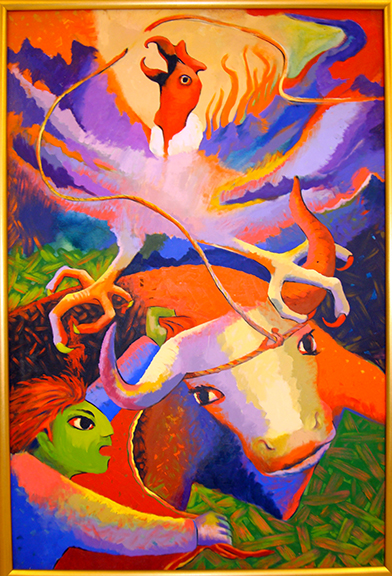
Florentino Laime Mantilla, Yawarchanakuson (Quechua) / Ensangrentemonos (Spanish) / Let us be covered in blood
Florentino Laime Mantilla
1960-
Quechua
Date
1998
Medium Specific
Acrylic on canvas
Classification
Painting
Dimensions
63 x 44 in. (160 x 111.8 cm)
Accession Number
2008.45.15.92
Credit
Gift of Susanna & George Grossman
Memo / Artist Statement
The painting portrays a traditional ritual activity which is almost extinct and is most commonly known as the "Yawar Fiesta" or "Blood Feast." In this event a condor is tied on the back of a bull. It signifies the coming together of the upper world, represented by the condor, and the underworld represented by the bull.
During an interview in Lannion, France, at the inauguration of the exhibit The colors and soul of the Andean Peruvians on August 3rd 2001, Laime Mantilla was asked about the colors and form of the faces he portrays. The artist explained that “the purple face is humble, which does not face openly, while the green face is hope in the future that life has to be different. We have the sadness, the failures, but we also have the innocence and we look forward to a better future”.
While at UC Davis, Laime Mantilla participated in a conference of indigenous studies in Davis where he made a lasting impression upon Emeritus Law Professor George Grossman who began collecting his works. Long-time supporters of the C.N. Gorman Museum, Susanna and George Grossman donated Yawarchanakuson / Ensangrentémonos which was made during Mantilla's residency.
During an interview in Lannion, France, at the inauguration of the exhibit The colors and soul of the Andean Peruvians on August 3rd 2001, Laime Mantilla was asked about the colors and form of the faces he portrays. The artist explained that “the purple face is humble, which does not face openly, while the green face is hope in the future that life has to be different. We have the sadness, the failures, but we also have the innocence and we look forward to a better future”.
While at UC Davis, Laime Mantilla participated in a conference of indigenous studies in Davis where he made a lasting impression upon Emeritus Law Professor George Grossman who began collecting his works. Long-time supporters of the C.N. Gorman Museum, Susanna and George Grossman donated Yawarchanakuson / Ensangrentémonos which was made during Mantilla's residency.
Biography
Florentino Laime Mantilla (b.1960) is a Quechua artist born in the village of Wakuyo, in the province of Chumbivilcas, southern Peru. He studied at the Diego Quispe Tito School of Advanced Studies of Fine Art in Cuzco and in 1998 served a four-month residency in the Department of Native American Studies at UC Davis through the Rockefeller Foundation Visiting Indigenous Artists-in-Residence Program.
Alongside his art practice, Laime Mantilla served as Mayor of the City of Santo Tomas, in the province of Chumbivilicas, from 1999-2002, where he undertook projects in social services and economic development for the benefit of the indigenous community. His political perspectives are visually embedded in his artwork through the preservation and empowerment of Andean cultural and political histories and the representation of indigenous experience. His paintings and drawings reflect a balance of violence and kindness, life and death, shadow and light, love and hate, the forces of nature, and the fragile nature of spirits. Laime Mantilla's originality is derived from his unique fusion of light and color. He portrays Quechua community events and feast days in much of his work employing a palette of brilliant reds, purples, blues and yellows, distinctly characterized by his use of geometric planes and pointillism.
Laime Mantilla has had numerous solo and group exhibitions in the US, Peru and France.
Alongside his art practice, Laime Mantilla served as Mayor of the City of Santo Tomas, in the province of Chumbivilicas, from 1999-2002, where he undertook projects in social services and economic development for the benefit of the indigenous community. His political perspectives are visually embedded in his artwork through the preservation and empowerment of Andean cultural and political histories and the representation of indigenous experience. His paintings and drawings reflect a balance of violence and kindness, life and death, shadow and light, love and hate, the forces of nature, and the fragile nature of spirits. Laime Mantilla's originality is derived from his unique fusion of light and color. He portrays Quechua community events and feast days in much of his work employing a palette of brilliant reds, purples, blues and yellows, distinctly characterized by his use of geometric planes and pointillism.
Laime Mantilla has had numerous solo and group exhibitions in the US, Peru and France.
